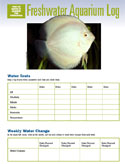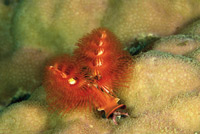
Q. I have a 75-gallon reef aquarium and am concerned — and perplexed — about the fate of some of my fish. In the last two months I have had a red parrotfish, a royal gramma, a watchman goby and a mandarin goby disappear. In each case I looked for their remains under the live rock after they had been missing for several days, but I could not find a trace of any of them!
All four of these fish were feeding and appeared to be doing well before they mysteriously disappeared. My local fish store expert told me that they were victims of a mantis shrimp, because I sometimes hear a clicking sound at night. But, I never see these shrimp and I still have a healthy population of small fish and inverts.
Every morning when I wake up, I run to the aquarium, cross my fingers and count heads to see if any more fish have mysteriously disappeared. Do you have any ideas as to the fate of these fish?
A. Unfortunately, mysterious fish disappearances are not uncommon in reef aquariums. There are many more places for a sick fish to hide and a variety of potential predators in an aquarium full of live rock. If a fish should die, the soft tissues will quickly decompose as a result of the large microbial fauna. Worms, crabs, shrimp, amphipods, isopods and many fish will act as scavengers, feeding on the cadaver.
Predation by invertebrates is also a possible cause of mysterious fish loss. And several of the species of fish listed in your letter are piscivores (fish eaters)!
Anemones are the invertebrates most often thought of as fish predators. However, most anemones do not feed on large prey, but instead rely on smaller quarry and the zooxanthellae (unicellular algae) in their tissue to provide nutrients. The stinging cells, or nematocysts, of anemones are usually not strong enough to incapacitate a healthy fish.
The carpet anemones (Stichodactyla spp.) are exceptions to this rule. They do have potent nematocysts that can immobilize large fish. In your letter, which was too long to reproduce in its entirety, you refer to your anemone as a green saddle-back anemone. This name is most often applied to Stichodactyla haddoni, a confirmed fish eater. Also, sick and dying fish will occasionally meander into a carpet anemone.
Because you have a carpet anemone, you must be careful when switching on lights after they have been off. If lights are turned on suddenly, a startled fish may race aimlessly around the aquarium and collide with this lethal invert.
Tube anemones (Family Cerianthidae) are also predatory cnidarians that can capture small fishes. Certain mushroom anemones (Order Corallimorpharia) will also consume fish. The elephant ear anemone (Amplexidiscus fenestrafer) is the most notorious of these. This species can grow to 16 inches in diameter and captures prey by envelopment. When a fish rests on the polyp it slowly closes around it. It has been suggested that A. fenestrafer mimics sea anemones to attract and then feed on anemonefishes.
Large fire (Hermodice caranculata), rag (Nereis spp.) and eunicid (Eunice spp.) worms have been reported to feed on small fish that were slumbering or dead. These worms have large, strong jaws and relatively capacious mouths, but are a greater threat to sessile invertebrates than live fish. Some rag and eunicid worms can reach lengths of more than 12 inches, but fortunately they are scarce in reef aquariums. Although fire worms are not uncommon in aquariums containing live rock, incidents of them eating live fish are no doubt rare. All these worms will feed on fish remains.
Another less significant threat to live fish are predatory snails. Several members of the Indo-Pacific genus Conus, known commonly as cone shells, are well known for their fish-eating habits. These snails have a harpoon-like radula, with an associated venom gland, which they use to paralyze their prey. The venom of some species is so potent it can even kill a human! It is fortunate for small fish, and aquarists, that these snails are rarely found on the live rock we add to our aquariums. Some large snails, like whelks, will also feed on carrion and may scavenge on dead fish.
Of all the invertebrates, crustaceans are probably the most likely fish assassins. Although the majority of carnivorous crabs feed on snails, clams, hermit crabs, starfish, sea urchins, sea cucumbers and brittle stars, most will dine on fish if the opportunity presents itself. Catching an active fish would prove difficult for a crab, but they can subdue fish that are sick or sleeping.
Inexperienced hobbyists often add hermit crabs, the calico crab (Hepatus epheliticus) and large arrow crabs (Stenorhynchus seticornis) to their aquariums without realizing that they can be lethal to fish. But, not all crabs are voluntarily introduced to the reef aquarium. Camouflaged crabs, like the hairy (Pilumnus spp.) and spider (Mithrax spp.) crabs, are often hitchhikers on our live rock.
You mention that a local shop owner suggested that a mantis shrimp may be responsible for your fish disappearing. I believe that this group of crustaceans have become scapegoats for many reef aquarists. After careful examination of the species that commonly come with our rock and a quick review of the scientific literature, I am not convinced that they are responsible for many, if any, fish losses.
There are about 300 species of mantis shrimp. Their second pair of legs, known as the raptorial claws, are folded up against the body and are used to fend off rivals and to capture prey. The claw is composed of five sections, the end section being the dactylus.
In some species the dactylus is sharply pointed or bears sharp spines on its inner edge. These species use this claw to spear shrimp, worms (including fire worms) and fish. In other species the dactylus is swollen toward the end and may have a sharp inner edge. In these species the raptorial claws function as a hammer to smash their quarry. When a prey item comes within striking distance the mantis shrimp quickly extends these two appendages — with lightening speed — and impales or thumps its victim.
Mantis shrimp range in size from 2 inches to more than 12 inches — the majority of specimens that come in on our live rock are under 3 inches in length, and belong to the genus Gonodactylus. The species in this genus have no teeth on the raptorial claws, but the dactylus is bulbous toward the end, indicating that it catches its food by smashing it.
It is my belief that these mantis shrimp pose little threat to fish in the reef aquarium. This is because smashers typically feed on snails, clams, crabs, hermit crabs and shrimp (this includes ornamental varieties), and most specimens that I have encountered in reef aquariums are too small to subdue anything but the smallest fish. Studies conducted on stomatopods have shown that those species that readily capture fish have heavy, sharp spines on the edge of the raptorial claw.
One of the simplest ways to rid your aquarium of these potential pests is to construct or buy a trap. Take a jar or plastic food container and make a hole in the center of the lid that is large enough for the crustacean to enter. Place a piece of scallop or shrimp in the bottom and lean it against your live rock just prior to turning out your lights for the evening. If a crab or mantis enters the jar to get the food it will not be able to climb back out.
The reef lobsters (Enoplometopus spp.) are voracious predators and should not be placed in a reef aquarium with fish. Large boxer shrimp, like the Hawaiian cave shrimp (Stenopus pyrsonatus), may also capture small fish when they are sleeping.
The most unusual piscivorous invertebrates belong to the sea star group. You mentioned in your letter that you have a large green brittle star in your aquarium. I would venture to guess from your description this is Ophiarachna incrassata, which is commonly sold as the green brittle star.
Most people are unaware that these creatures employ a unique ambush feeding strategy to capture small fish. This brittle star will lift its disc above the bottom, remain motionless and wait for a fish seeking shelter to swim under its disc. When this happens the star quickly turns its body — so that its legs are twisted in a spiral — and imprisons the fish in its spiny arms! The trapped fish is then easily consumed by the crafty echinoderm. This species may also feed on sleeping or sick fish. Therefore, it may not be a bad idea to remove this brittle star because of its predatory nature.
 Aquarium maintenance logs for freshwater, saltwater and reefkeeping aquarists
Thank you for signing up for the FishChannel newsletter, the
Aquarium maintenance logs for freshwater, saltwater and reefkeeping aquarists
Thank you for signing up for the FishChannel newsletter, the
 Canister Filters
In this article we will deal with a type of filter that many
Canister Filters
In this article we will deal with a type of filter that many
 Aiptasia
Q. I have Aiptasia all over my aquarium and have been
Aiptasia
Q. I have Aiptasia all over my aquarium and have been
 Useful Idea For Stronger Nutrition And Wellness
It truly does show when you take time to create a proper no
Useful Idea For Stronger Nutrition And Wellness
It truly does show when you take time to create a proper no
 Catch More Salmon - Follow These Simple To Implement Techniques
FLAT Rigs outriggers, shock cord snubber, and rigging kit i
Catch More Salmon - Follow These Simple To Implement Techniques
FLAT Rigs outriggers, shock cord snubber, and rigging kit i
Copyright © 2005-2016 Pet Information All Rights Reserved
Contact us: www162date@outlook.com